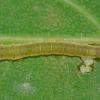35.147 Carpatolechia decorella (Haworth, 1812)
Status and Distribution
Widespread but local across much of England, Wales and Scotland; very local in Ireland and Northern Ireland. Absent from Isle of Man, the north of Scotland, including the western and northern Isles, and the Channel Islands.

Provisional map
Foodplant and Larval Feeding Signs
Quercus spp. (oak), see distribution map, and Cornus sanguinea (dogwood). In Dalkey, Ireland, in 1992 a single female was bred from oak galls collected in late June and emerged in mid-July. It seems most likely the larva had entered the gall to pupate.
In Europe reported as polyphagous feeding on the leaves and/or inflorescences of Abies alba (european silver-fir), Quercus ilex (evergreen oak), Q. coccifera, Q. robur (pedunculate oak), Q. rotundifolia, Cottinus coggyria, Pistacia vera, P. terebinthus, Rhus sp. (sumach), Cornus mas (cornelian-cherry), Opix sp. and Phillyrea species.
Feeds in a folded leaf.
Habitat
Deciduous woodland, parkland and scrub.
Finding the Moth
Larva: feeds within a folded leaf.
Adult: during the day, can been disturbed from vegetation (such as sapling oaks), found on oak trunks (on one occasion seen scuttling on the trunk in sun) and rarely on posts, later coming to light in small numbers. During the hibernation period has been beaten from thatch and found overwintering in a garage.
Similar Species
A variable species with forewings ranging from pale grey with black markings, to all-over dark fuscous with only faint traces of the black markings. Despite this it is a fairly distinctive moth with slender wings and the black costal bar near the base of the wing, visible in all but the darkest specimens (these may require dissection for confirmation). Some other Carpatolechia may have a black sub-basal spot on the costa but lack the black bar.
Single brooded in Britain but in more southerly parts of Europe it has two broods.
The moth usually appears July and has then been recorded on the wing until as late as November when it then overwinters. Depending on the weather moths are then found on the wing from late February and March until late April or into May. Records of the adult in June are likely to relate to a combination of last year's hangers-on and those emerging early. It has been found as an adult in every month of the year. Peak periods for finding the adult are from early July to late August and again, to a lesser extent after hibernation, in March and April. This suggest the moth is single brooded throughout the British Isles but a second brood could be difficult to spot and would rely on larvae being located in August or September.












%202_0.jpg)
_0.jpeg)




